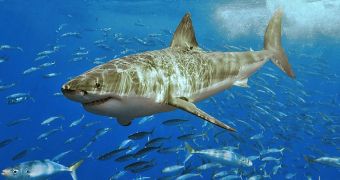A team of investigators from the United Kingdom is currently working on setting up the first ever visual biometrics database of Great White Sharks in the world.
The tool is bound to help researchers in several fields conduct their investigations on the largest predators to roam our planet's oceans.
Great White Sharks are now present in the waters only in very small numbers, and so investigators are keen on learning as much as they can about them until they go extinct.
Pollution and the decline of fish supplies is threatening the large predator, and experts are currently trying to develop conservation plans that would see the Great White surviving for decades to come.
Each of these creatures has a unique dorsal fin, which can be used to identify them similar to how fingerprints are used to identify each human.
The new biometrics database would store images of fins, collected as researchers encounter the animals, and capture them for tagging or study, experts at the University of Bristol say.
“We are developing the software for a system that will be able to automatically recognize features of White Shark dorsal fins using 'computer vision' technology, and then archive the animal information along with their Ids,” says Dr Tilo Burghardt.
He is a part of the international collaboration of investigators who are working on the project, and he is based at the UB Department of Computer Science.
“We hope it will be usable within two years, with members of the public able to participate,” the expert says of the biometrics database.
The photographic based fin-printing identification system that allows researchers to quickly identify individual sharks has been designed and developed by the founder of NGO White Shark Trust, Michael Scholl.
The expert explains that his innovation can be used to identify individual White Sharks over long periods of time, without interfering with the way the animal lead their lives in a disruptive manner.
“An automated software-based identification system is necessary for building an international centralized database for scientists to be able to collaborate and work together efficiently,” he adds.

 14 DAY TRIAL //
14 DAY TRIAL //